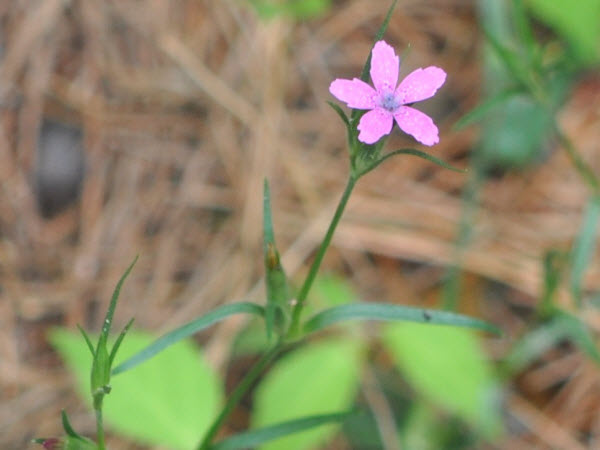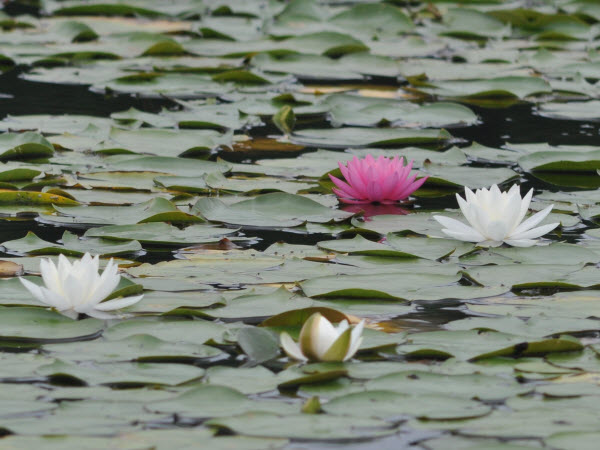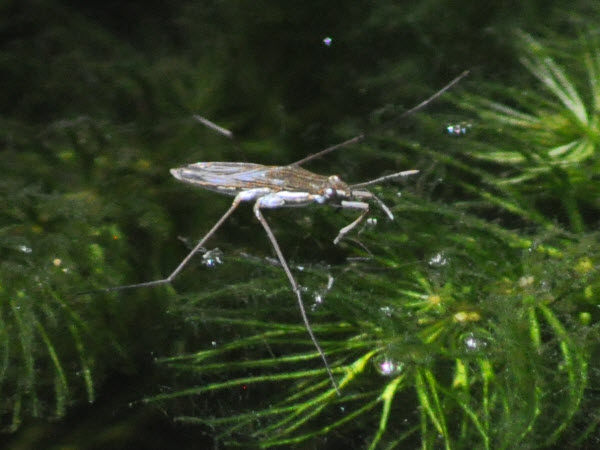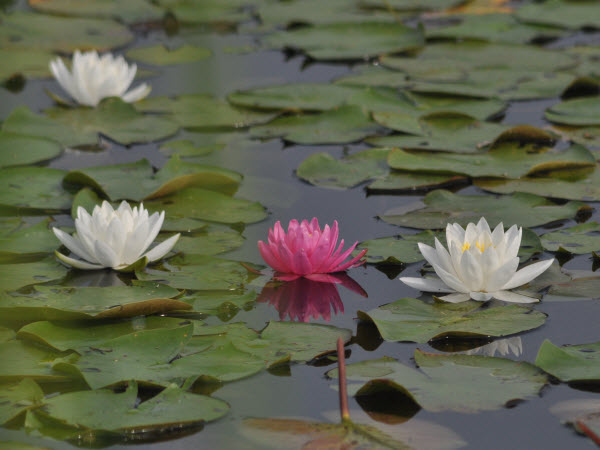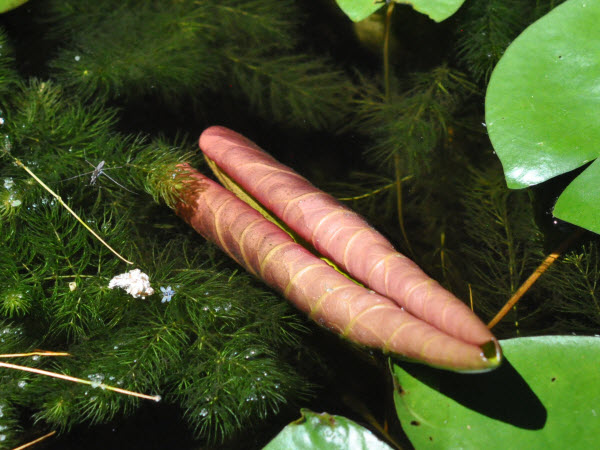I thought this was a striking view of an Oak tree blooming in late April, Indianapolis, IN area, April 29. There had been a sizeable storm, moving out to the East, and so at the time of this picture the sun was low in the sky to the West, still a dark storm sky to the East, and so the tree is well lit with a dark background. Not surprisingly, there was a very strong rainbow in the sky, with a very visible secondary.
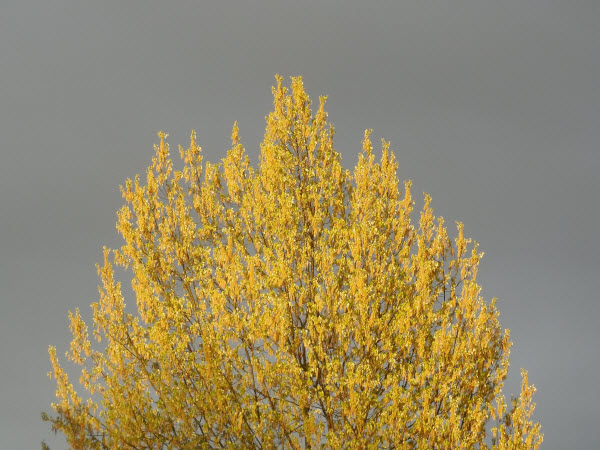
Catkins
Birch and Alder trees
Two deciduous trees produce a fruit, known as a catkin: Birch, and Alder trees.
The Alder tree belong to the birch family. Their leaves are small, alternate, simple and serrated. Alder trees are commonly found near streams, rivers and wetlands.
The Birch tree leaves are alternate, simple, pinnately-veined, ovate to nearly triangular in shape, pointed at the tip.
The fruit of the birch tree are cylindrical and about 1 inch long, and are deciduous at maturity, releasing 2-winged nutlets. The fruits mature in late summer and are dispersed in early autumn.
The fruit of the Alder tree are referred to as catkins. The male catkins are long and light-green, while female catkins are purple, ball-shaped and woody. The fruit may remain on the tree until the following spring. The small nut-like seeds provide winter food for birds and small mammals.
Alder tress can fix nitrogen from the air, in the same was as legumes.
references:
www.2020site.org/trees/alder.html
https://en.wikipedia.org/wiki/Alder
http://treesforlife.org.uk/forest/mythology-folklore/alder/
dendro.cnre.vt.edu - European Weeping Birch
The Alder tree belong to the birch family. Their leaves are small, alternate, simple and serrated. Alder trees are commonly found near streams, rivers and wetlands.
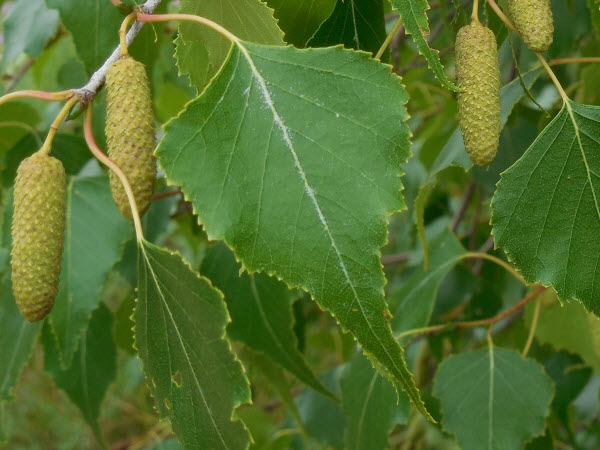
The fruit of the birch tree are cylindrical and about 1 inch long, and are deciduous at maturity, releasing 2-winged nutlets. The fruits mature in late summer and are dispersed in early autumn.
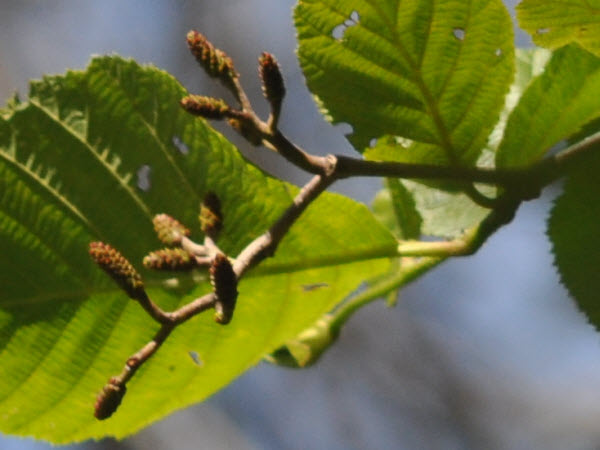


The Birch tree leaves are alternate, simple, pinnately-veined, ovate to nearly triangular in shape, pointed at the tip.
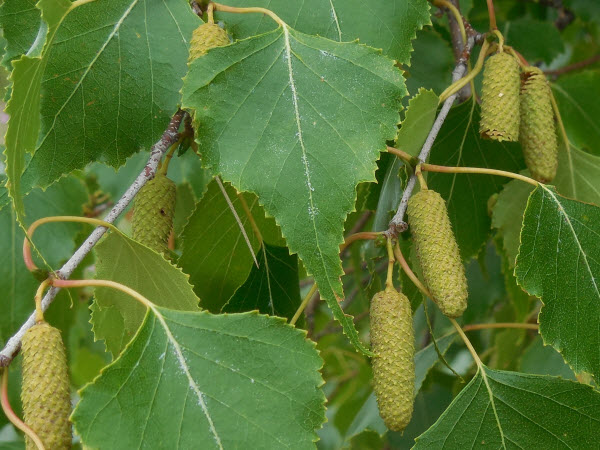
The fruit of the Alder tree are referred to as catkins. The male catkins are long and light-green, while female catkins are purple, ball-shaped and woody. The fruit may remain on the tree until the following spring. The small nut-like seeds provide winter food for birds and small mammals.
A birch tree against a striking blue sky. I did not notice the seed pods in this birch tree until I looked at the photo at full resolution - detail in the image that follows. In fact, I did not know that birch trees produced seed pods - after looking this up, I returned to look more closely - also a few months later, and by that time the leaves were down and much easier to see and photograph.
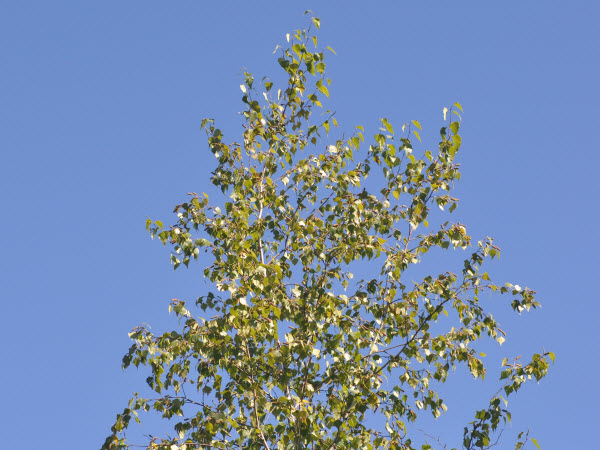
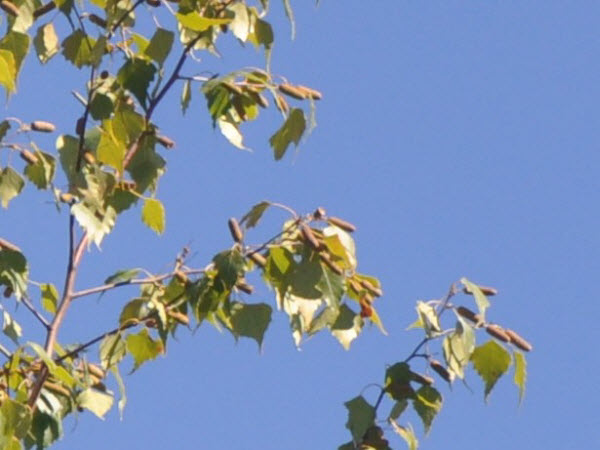
Birch seed pods
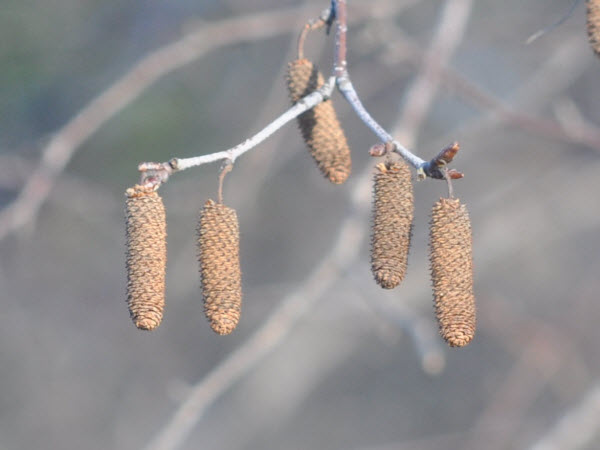

Black Sooty Mold Fungus.
I thought yet another invasive and / or damaging agent for the trees in our woods. I spoke with a nature center staff member (Indiana State Park), who said this is not harmful to the trees. And this reference: aces.nmsu.edu, "Black sooty mold fungus on tree branches", which says:
this is a "minor fungus that grows on the syrupy excretions of some insects that feed on trees. The fungus does little physical damage to the tree. The insects may be a greater problem, but even they may not be a major problem."

Baneberry
White Baneberry - Actae pachypoda
Both the berries and the entire plant are poisonous to humans. The berries contain cardiogenic toxins which can have an immediate sedative effect on human cardiac muscle tissue, and are the most poisonous part of the plant. Ingestion of the berries can lead to cardiac arrest and death. The berries are harmless to birds.
A member of the buttercup family. White baneberry is in flower from May to June, grows 1 – 2 feet in height, produces toothed compound leaves, and is topped with feathery white flower clusters that are taller than they are wide.
Ref: http://www.friendsofeloisebutler.org/pages/plants/redbaneberwhite.html
ref: http://www.scottbrothersnursery.com/woodland.htm
Ref: http://en.wikipedia.org/wiki/Actaea_pachypoda
Ref: http://vtnature.blogspot.com/2011/09/look-for-it-now-white-baneberry.html
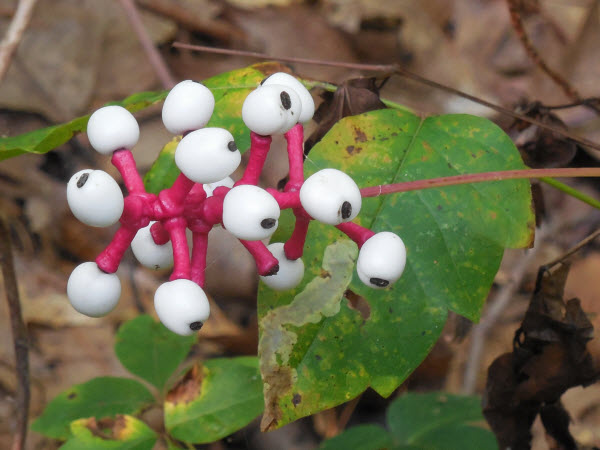
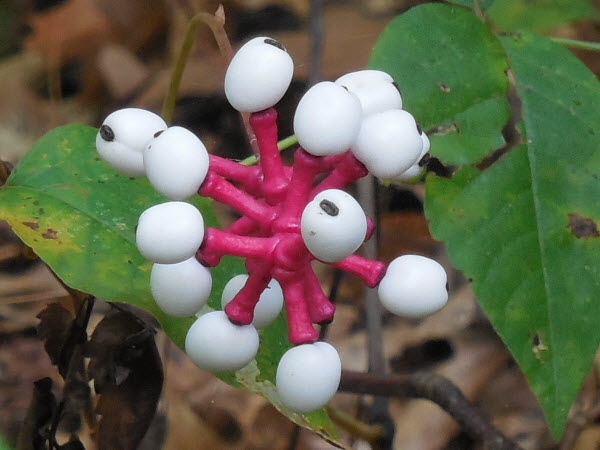
Wool Grass (Scirpus cyperinus)
I can't say better than presented in this reference: Wool Grass (Scirpus cyperinus) - French Hill Pond Emergent Plants
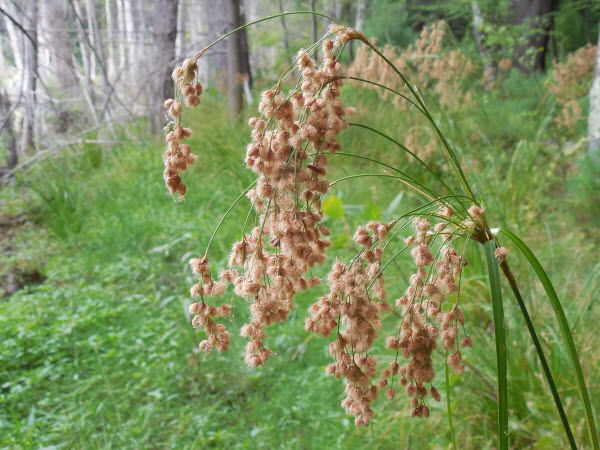
Skunk cabbage emerges early, while there is still lots of ice and snow around, found in wet areas - a stream or marsh. The first part of the plant to emerge is a shell-like pod, typically brownish-purple, with green splotches, known as a spathe (ref: www.fcps.edu/islandcreekes/ecology/skunk_cabbage.htm). In late spring the skunk cabbage will send up a tightly rolled leaf which will become one or two feet long and a foot wide.
Some aspects of the skunk cabbage that I find interesting:
How does the spathe become the huge leaves that dominate wetland areas?
Inside the spathe is a structure, the spadix - a little knob covered with small yellow flowers. I had never noticed this - after reading the reference listed just above, I had to wait until the next season to go back and examine more closely the young skunk plants. Of course, being in several inches of icy water can be a disincentive to kneeling down to more closely inspect the plant!
And - the skunk plant is Thermogenic - able to generate its own heat!
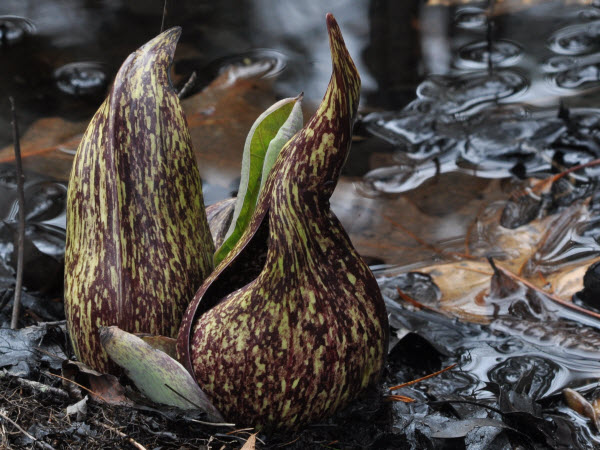
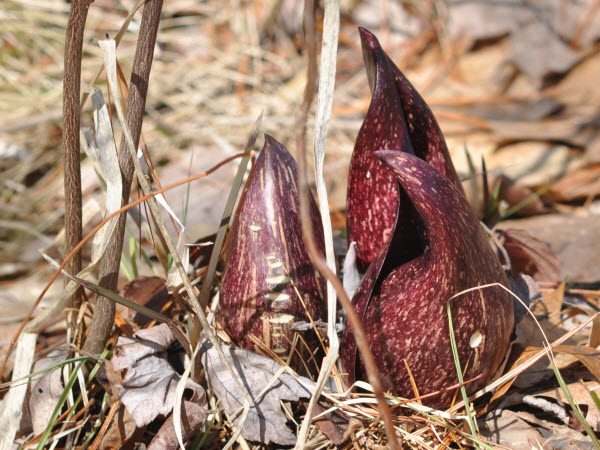
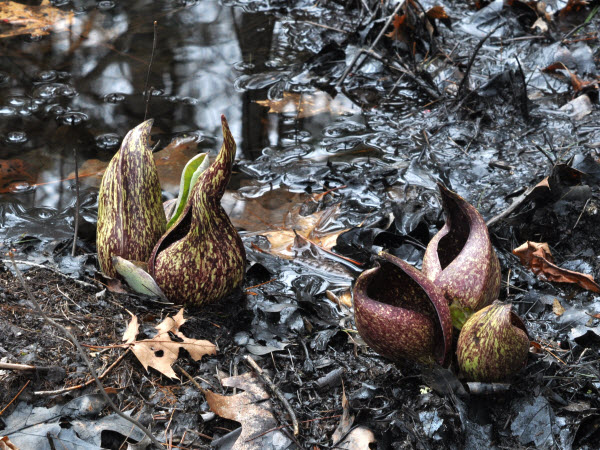
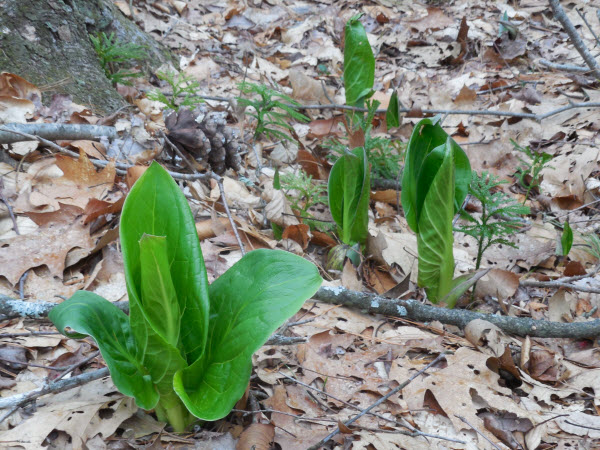


Early risers - the skunk cabbage become apparent as early as mid-February in Massachusetts. The ponds typically do not thaw for another month. However, the skunk cabbage grow in wetlands, often areas where spring water is welling up, warming the ground some.
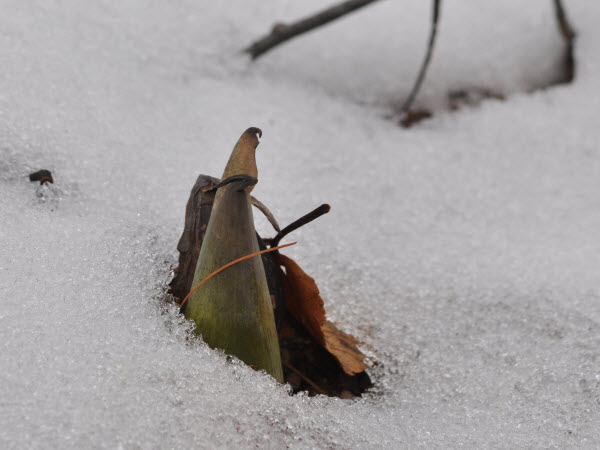

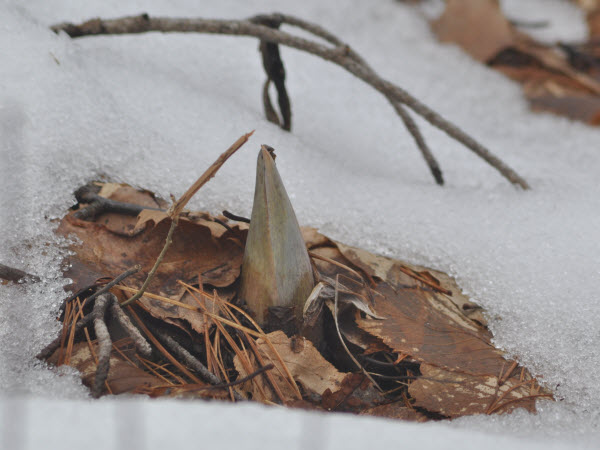
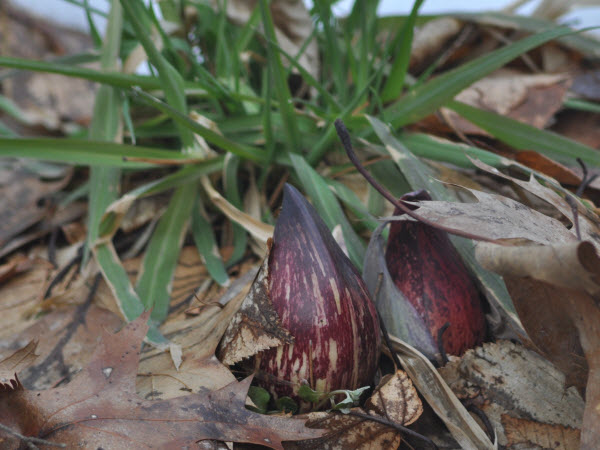
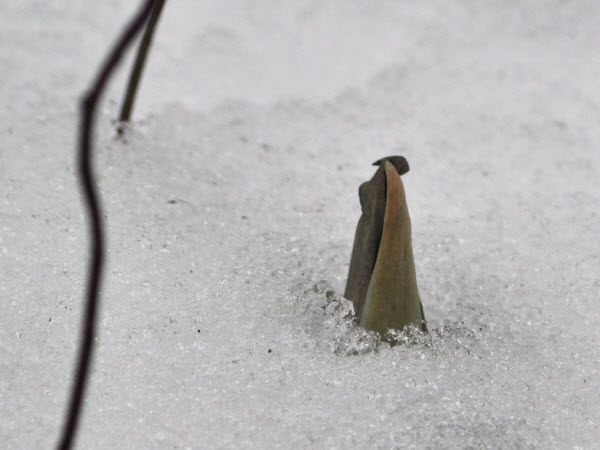
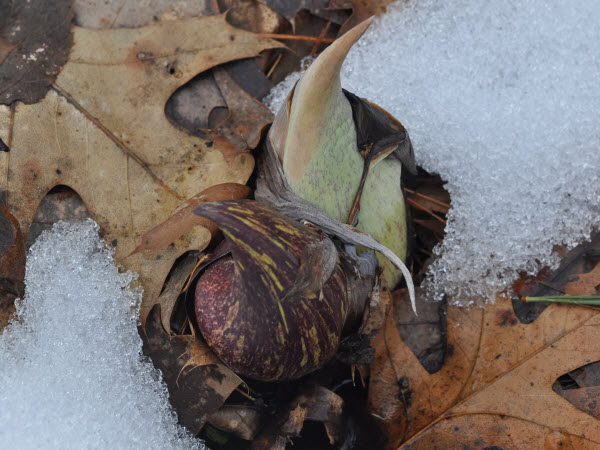

Getting from the hard shell of the spathe to the huge, broad leaves of the skunk plant has been my challenge. I see the characteristic early skunk plant form, and later the wetlands areas covered with the 2-foot leaves of the plants, and they seem like different plants.
The series of pictures, here, steps right through that - beginning with emerging of a tightly rolled leaf, which then unrolls and grows to the large leaf.

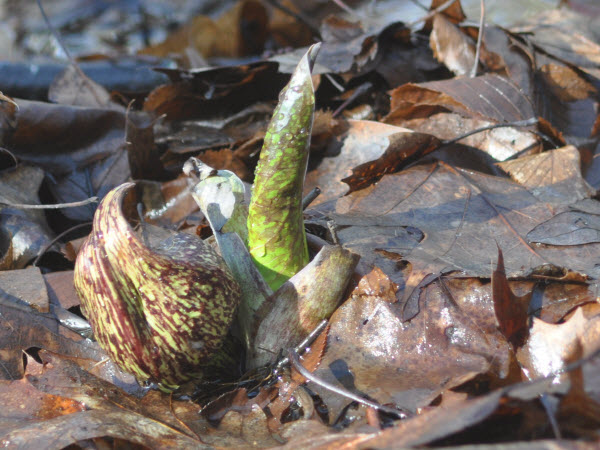
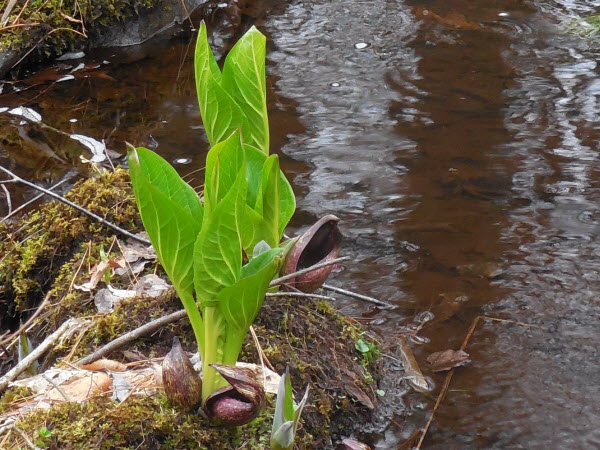

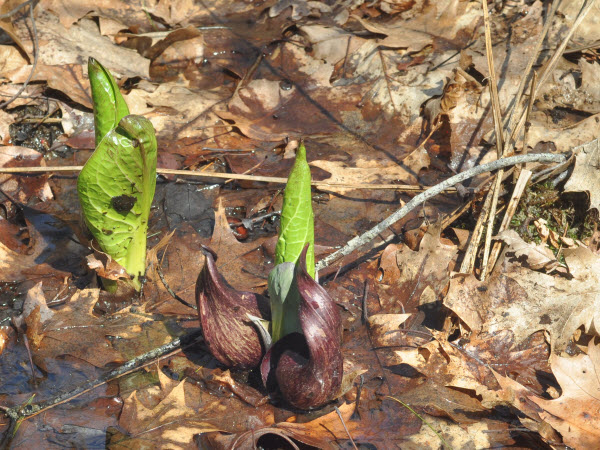
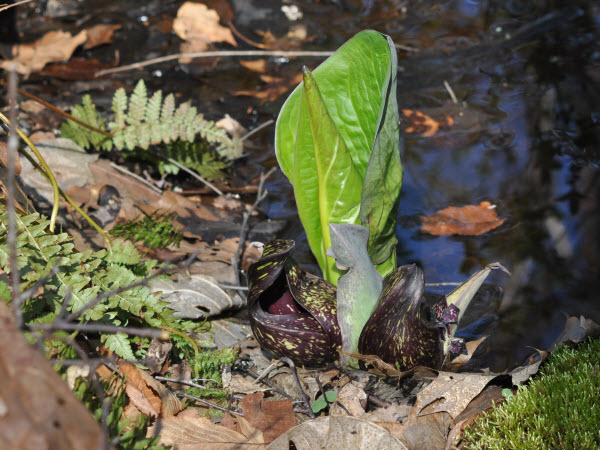


Spadix
The spadix - the flower of the skunk cabbage. Last year I collected photos of the skunk cabbage and then looked for information - and learned that inside the spathe is the flower structure - the spadix. I had to wait until this year to visit my favorite skunk cabbage spots to look for the spadix. And then an article referenced next, and have to wait until next year so that I can look more closely. Of course it does not help that I am generally in six inches or more of icy water at this time of year - not so conducive to getting down low to really see!
The reference: natureinstitute.org - skunkcabbage.htm - nicely written, comprehensive and interesting to read.
As I understand the description provided in the reference above, the spadix is a substantive structure, supported on a stalk, and containing "numerous small, tightly packed individual flowers".
The flowers have no petals. They do have four fleshy, straw-colored sepals that never really unfold.
The flowers "bloom" when the stamens grow up between and above the sepals and release their pale yellow pollen. Following this, the style grows out of the middle of each flower to be pollinated by insects carrying pollen from other flower heads.
I think my images are all from early in this process - the spadix is clearly present, with the numerous individual flowers. The sepals are visible, especially in the <description>. But the stamens have not yet grown out, and the style is not apparent at all.
So, I have to wait until next year for more pictures!
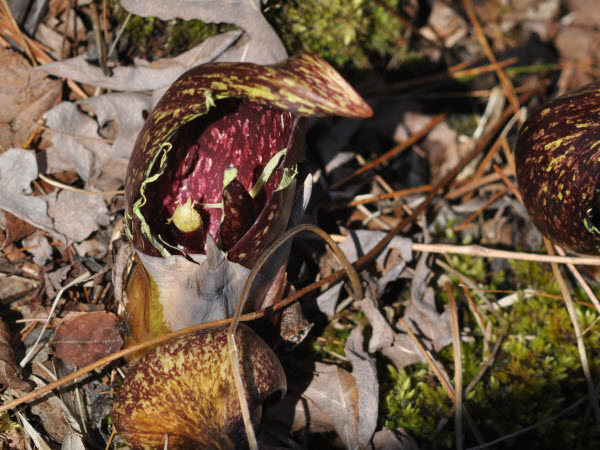
The images are the same - left side shows the entire spathe and spadix inside. Right side is cropped to the spadix, at full resolution.

The same image is shown above, right side is cropped to show just the spadix at high resolution. Below, a different flower. In all of these I believe the sepal is apparent at the four "leaves", and no evidence of the stamen or style.
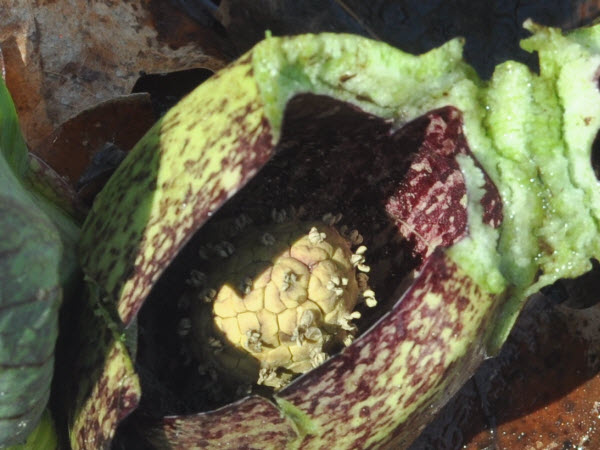
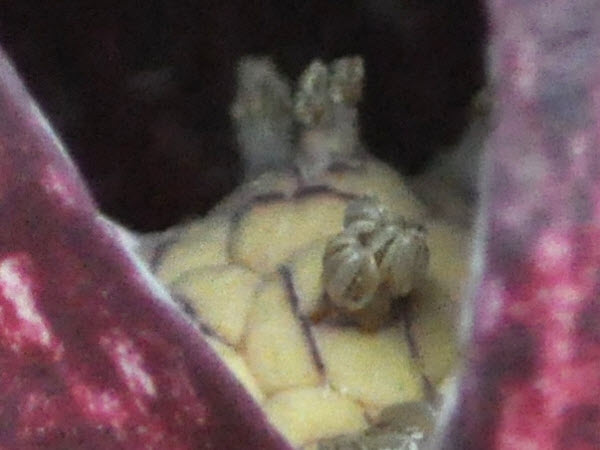

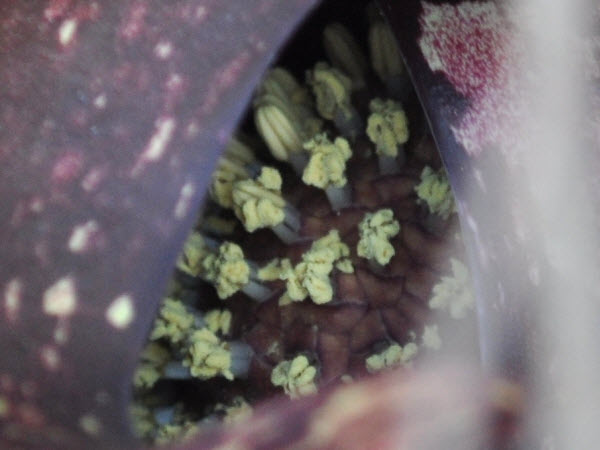
So much effort spent carefully stepping through just thawing swampy areas looking for skunk cabbage opened enough to see the spadix, oriented just right to let a bit of sunlight in - and then my big cloddy feet took the top right off a young cabbage! But - now an unimpeded view of the spadix...

I think the spadix includes both the yellow flowers and the purple structure forming a tube. still have to do more digging. It was a bright day, and exposure compensation was not quite enough to avoid over-saturation, but there is still good detail to be seen.
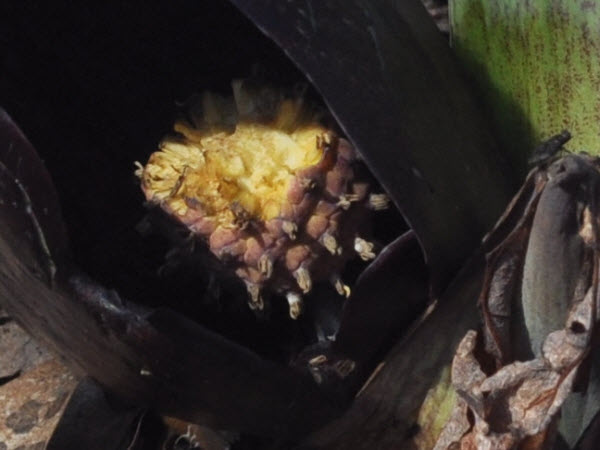

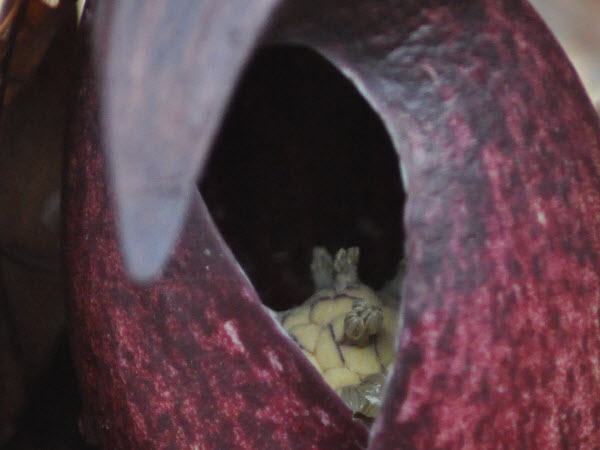
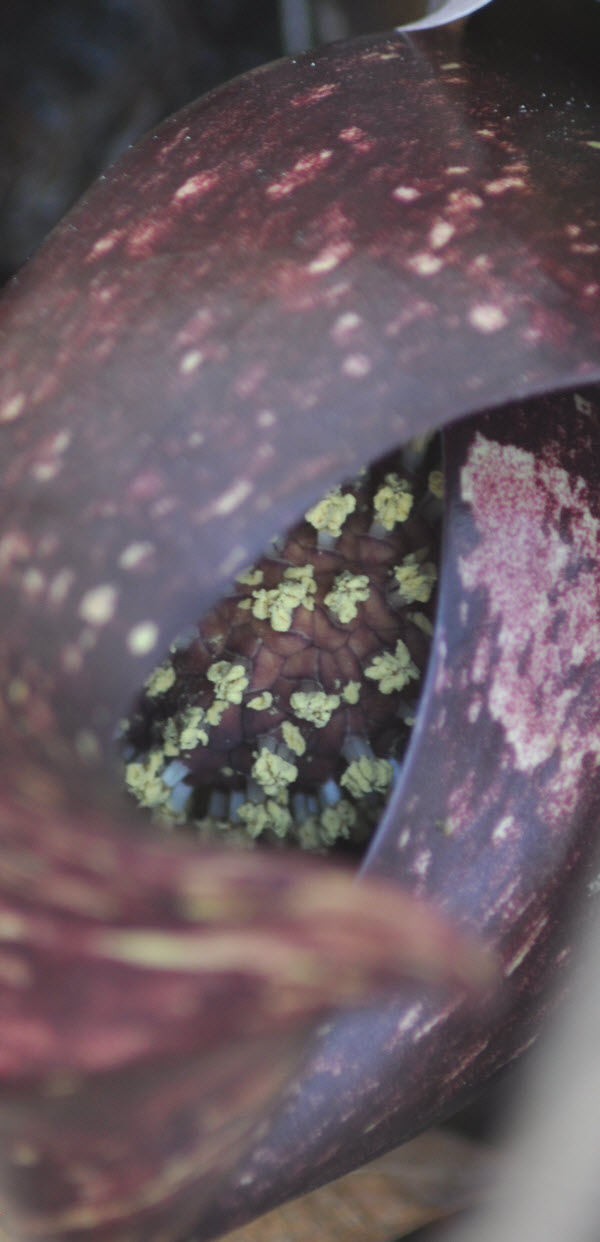

2020 - I have taken so many pictures of skunk cabbage! But I am always looking for a better image when I am out. The spadix is difficult both because it is well protected and generally enclosed, and also because the sun is always at the wrong angle to show off the flower. Finally, though, I found this skunk cabbage showing off the flower in full sun!

Thermogenisis
Thermogenesis is the plant ability to generate heat, utilizing mitochondria, the same organelles central to energy production in mammalian cells.
I found some very good references for thermogenesis. The NatureInstitute reference listed above, and these:
www.damninteresting.com/warm-blooded-plants
Wikipedia
www.ncbi.nlm.nih.gov/pubmed/1519313
www.els.net/WileyCDA/ElsArticle/refId-a0001680
From these, a few things that I found particularly interesting:
- There are not many Thermogenic plants - they include eastern skunk cabbage, Voodoo Lilly, Philodendron, and several species of Arum (corpse flower)
- Plants have mitochondria, which use an electron transport chain to generate ATP - mitochondrial respiration - and are an integral part of photorespiration, in concert with chloroplasts and peroxisomes.
- In Thermogenic plants, there are two-noncoupled NADH dehydrogenases that oxidize pools of NADH. I think it is fair to say that this process is short-circuiting ATP production in the plant, resulting in heat production.
- Skunk cabbage generates heat for only a few days, within the flower head. This warmth creates circulation of air as the warm air rises through and out the top of the spathe and new air is pulled in from the bottom. That warm, odiferous air is what attracts the first insects of spring (NatureInstitute ref).
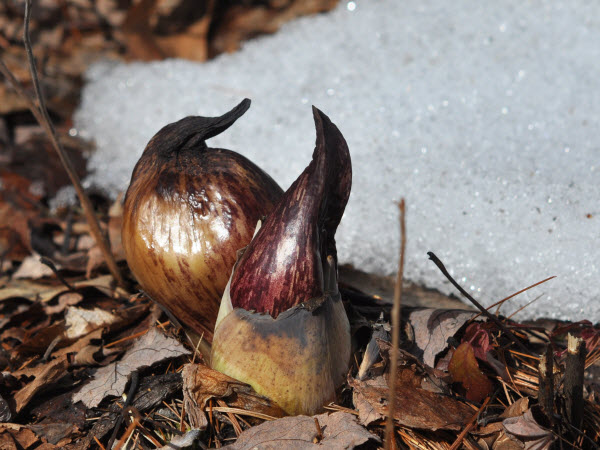
Oak Gall
Also Apple Oak Gall, Oak Gall Wasp.
It is common to see these structures while hiking in the woods, sometimes still connected to and part of a tree, and sometimes loose on the ground. On a recent walk I was curious enough to cut one open, and found a small cluster of larvae. On reading several different sites I learned that these structures are specific to Oak trees, and are created by the tree in response to the egg of a particular bee, the oak gall wasp. The structure forms from a single oak leaf - the wasp lays eggs inside the central vein of the leaf, and the leaf then forms the round gall shape. The characteristics of the gall are very specific to the species of wasp, and in fact I understand that the identity of the wasp can be determined by the characteristics of the gall!
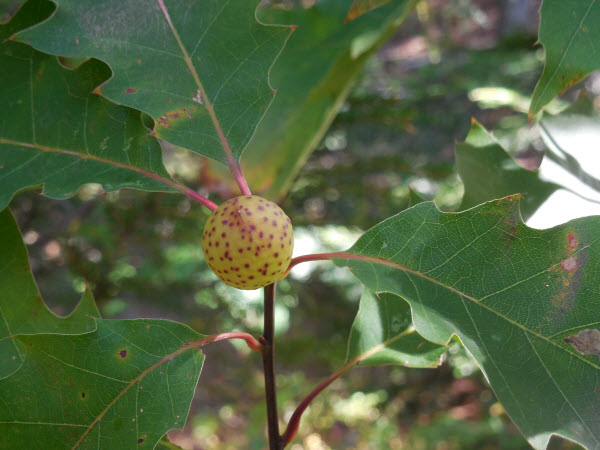

On a recent walk I was curious enough to cut one open, and found a small cluster of larvae.

The structure forms from a single oak leaf - the wasp lays eggs inside the central vein of the leaf, and the leaf then forms the round gall shape. The characteristics of the gall are very specific to the species of wasp, and in fact I understand that the identity of the wasp can be determined by the characteristics of the gall!

It is common to see these structures while hiking in the woods, sometimes still connected to and part of a tree, and sometimes loose on the ground.
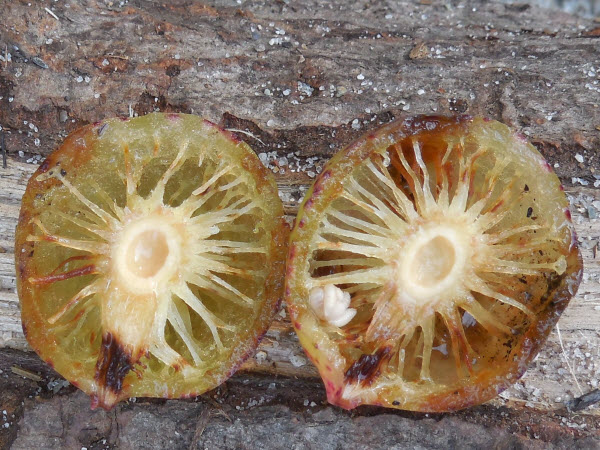
On reading several different sites I learned that these structures are specific to Oak trees, and are created by the tree in response to the egg of a particular bee, the oak gall wasp. The structure forms from a single oak leaf - the wasp lays eggs inside the central vein of the leaf, and the leaf then forms the round gall shape.
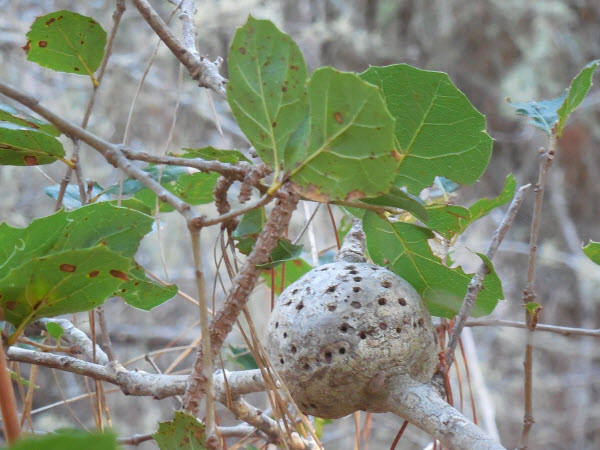
Moss, bright cover of a rock in winter (Dec 31, 2013). New England winters can last a long time. I like the winter and the snow, and am out every week with my dogs - sometimes or often times with snow shoes. There can be a distinct lack of color in the winter - to the point that pictures seem to be black and white - this said by someone who shot exclusively black and white film for many years. In this context, the mosses offer a welcome and vibrant green color, even in the coldest winters. The picture below is reasonably common - a moss covered rock taking warmth from the sun on a very cold day. It is not unusual that, once the first significant snow falls in December or January, the snow remains into March.

In the spring, the mosses are clearly very busy. I found a good reference describing moss reproduction, http://www.countrysideinfo.co.uk/moss_article/page1.htm "Miraculous Mosses". I will have to look more carefully next spring to see more of the story for myself.
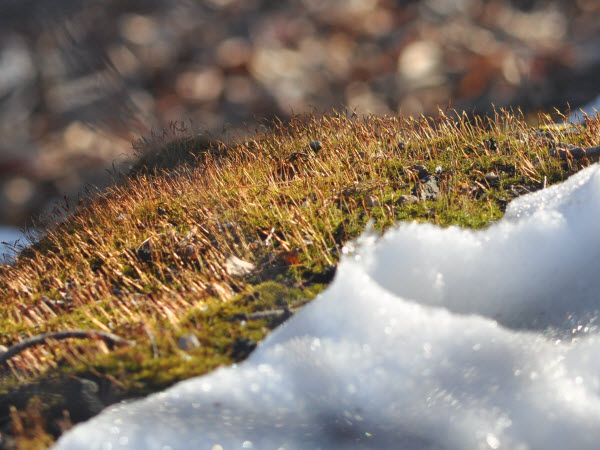
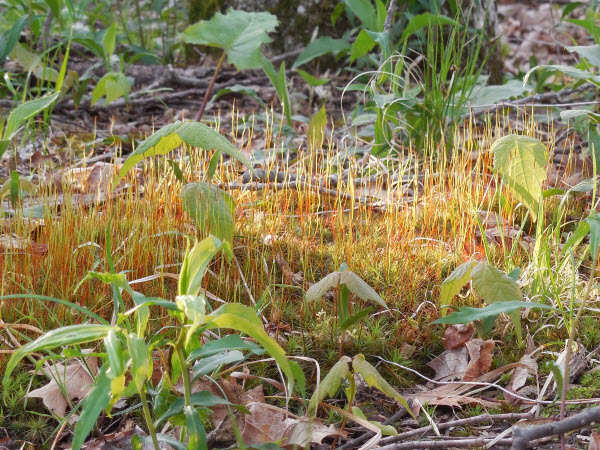
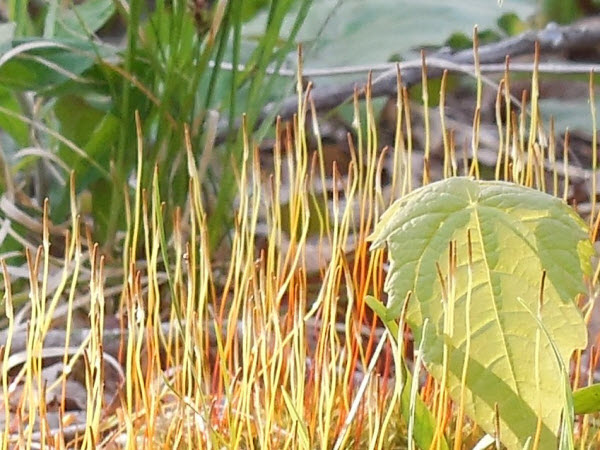
Cottongrass
The photo below is a wetlands area, marsh, and really not approachable other than by wading in through the water. The white plant is cottongrass, and I spent a lot of time trying to identify. Part of my problem was getting a good view of the plant - I could not get close, and so relied on photos - but that was frustrating too - a good 300mm telephoto lens helps, but I was late in the season (October 26), and there is so much vegetation that it is difficult to resolve what was the cottongrass. I finally put the words "cotton" and "marsh" to an Internet search - that brought up photos labelled as cottongrass, and a search on cottongrass did the trick!
A nicely done web site is http://www.bio.brandeis.edu/fieldbio/, and consists of pages created by different students identifying plants and bugs. The page that pertains here is http://www.bio.brandeis.edu/fieldbio/Wildflowers_Kimonis_Kramer/PAGES/COTTONGRASS_PAGE_FINAL.html
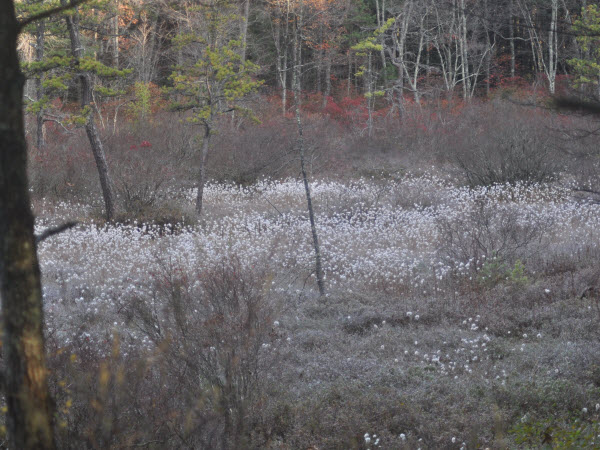


I have had the problem that cotton grass grows too much within a marshy area to get close enough to really see the plant. Recently I was able to get much closer - a dry spell had caused the water levels to drop a lot. Although I was surprised on this day to put a foot down - softly - only to have it sink up to my knee!
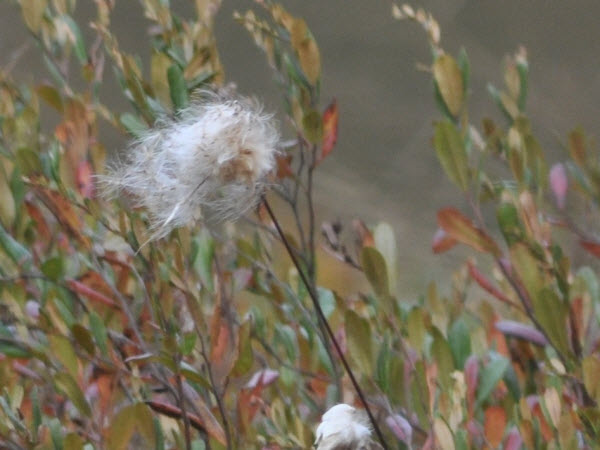

I found an area with cottongrass and ground that was sufficiently firm that I could venture in, and found plants with developing buds.
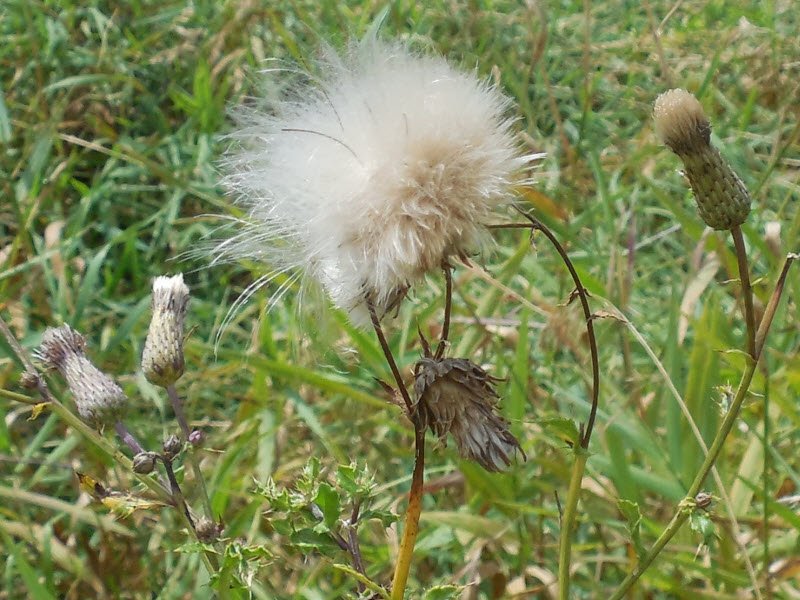
Cattails
These photos are all along rivers in the Concord, MA area.
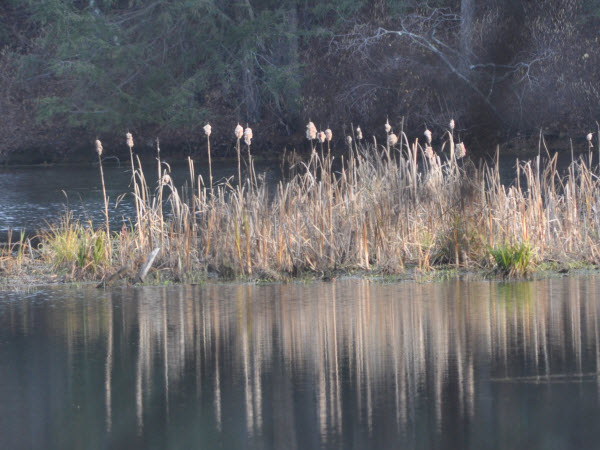

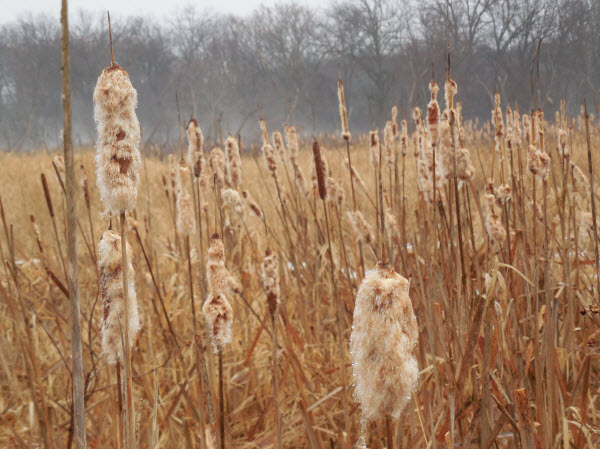
Milkweed
Over time I have found that I have a surprising number of pictures tied to the milkweed - there is the plant with blossom, seed pod, seeds and white fibers for travel on the wind. The Monarch butterfly and Milk Weed Bugs, of course. Recently I found a large number of Tussock moth caterpillars - amazing eaters of the leaves - I have a picture with the caterpillars under the leaf - all that shows are the eyes on their heads as they are lined up munching on the receding edge of the leaf. The flower fly, and any number of bees, wasps, flies, and more. In fact, I found a reference (US Forest Service) that says that there are over 450 insects known to feed on some portion of the plant - wow!
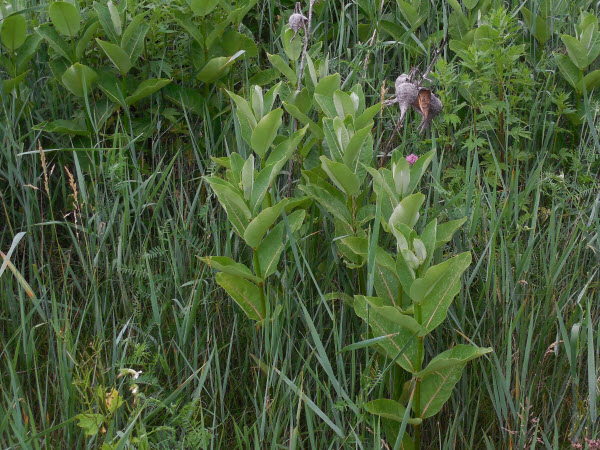
The milkweed plant is an interesting plant year round, able to thrive in areas of full sun and limited water. The plants grow in colonies, propagating via rhizomes - runners under the ground that send out roots and shoots, such that clusters of milkweed are found.
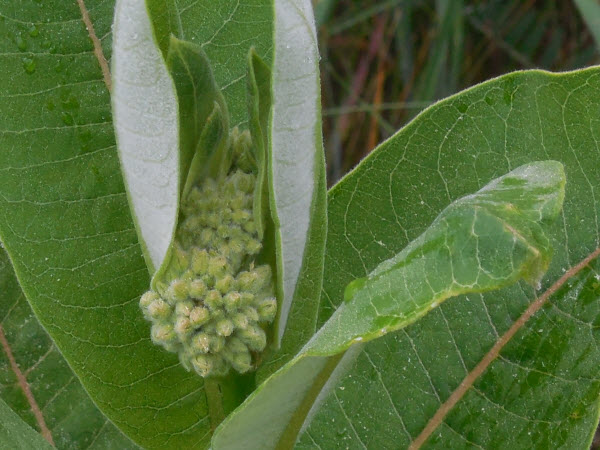
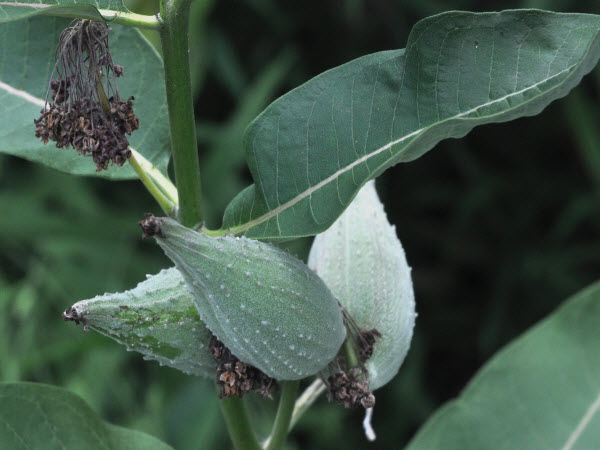
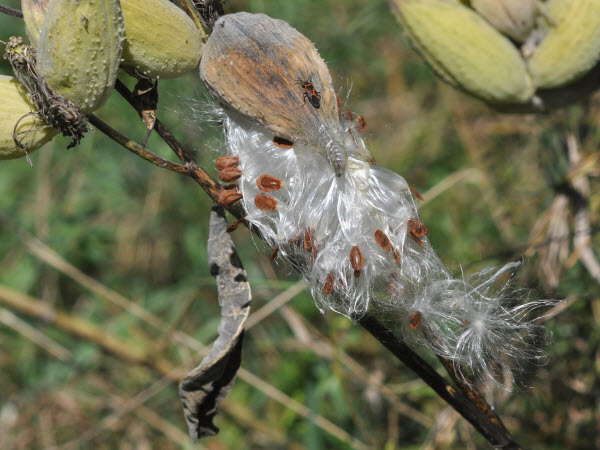
When the pods open, countless seeds are revealed, organized in orderly rows, with white, fluffy coma ("parachute") that allow for wind dispersal.
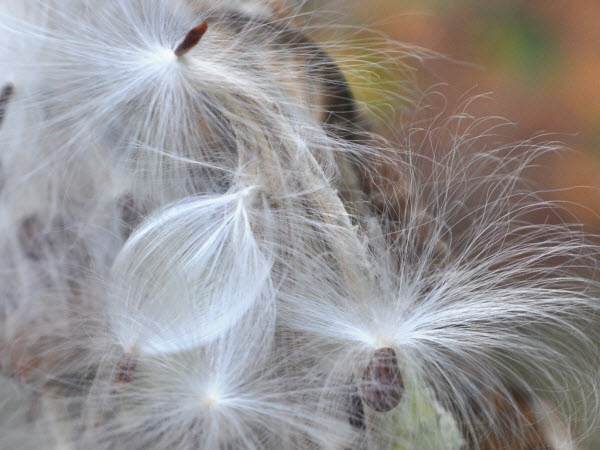
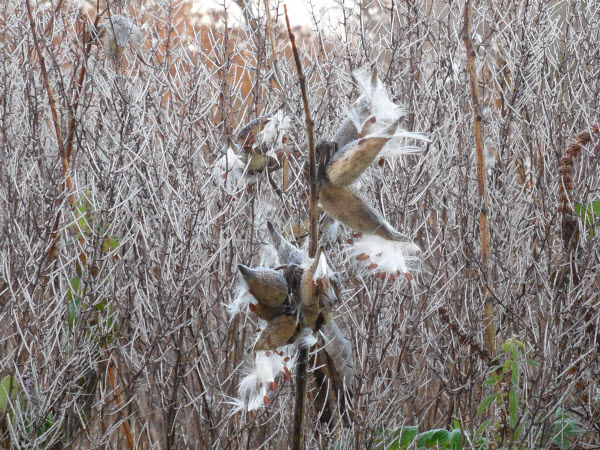
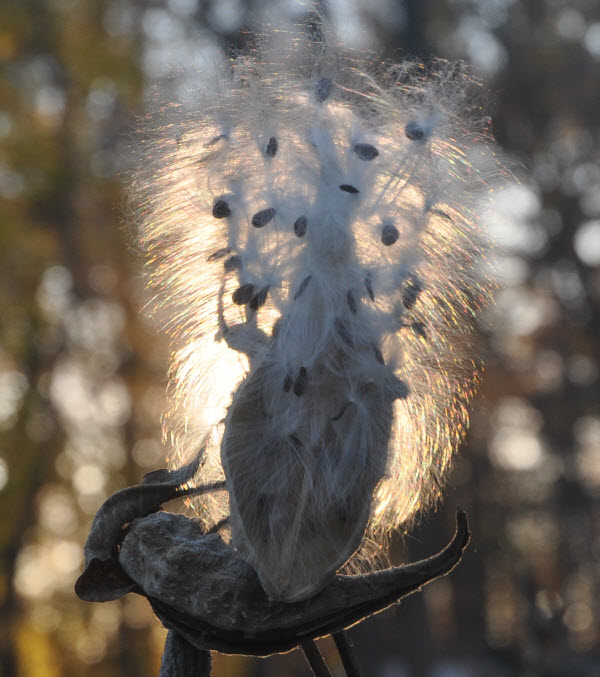

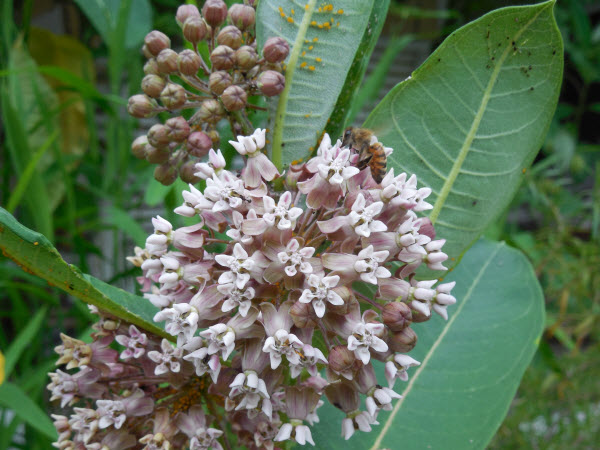
Clusters of flowers appear in the spring, followed by seed pods that mature in late summer. The flowers form clusters (umbels) at the top of the plant - usually 2 - 5 clusters per plant.

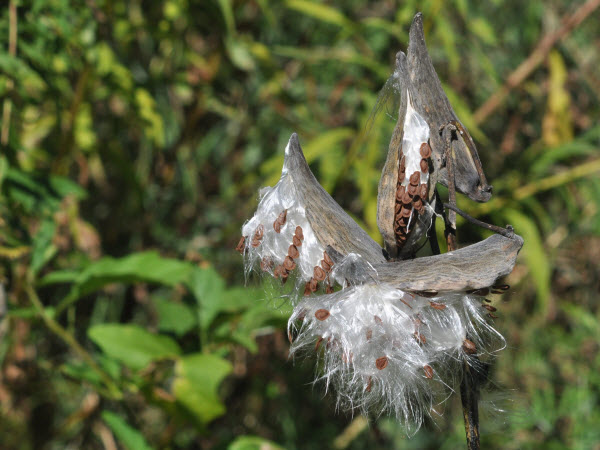
The seed pods often remain present through the winter and into the next season. The last photo in this series is taken in November, after a heavy frost has coated all of the plants, setting off the seed pods. And the first picture in this series shows off a new plant in early spring, with seed pods still present from the previous season.
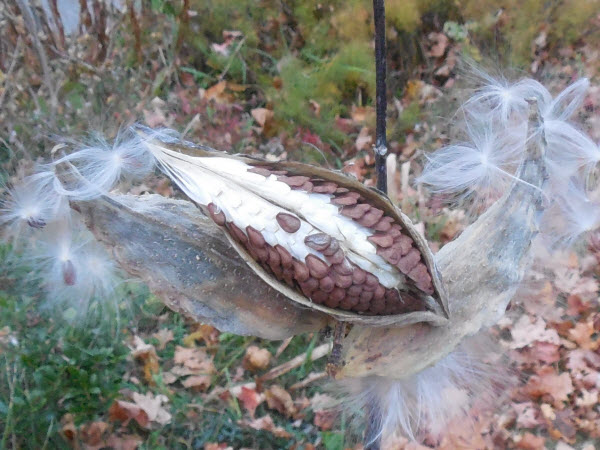
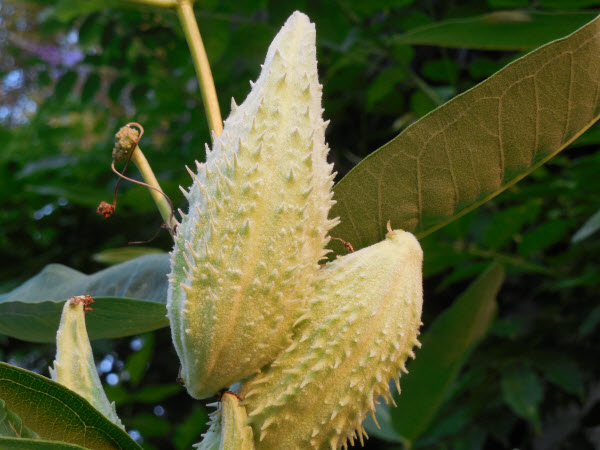
Monarch Butterfly

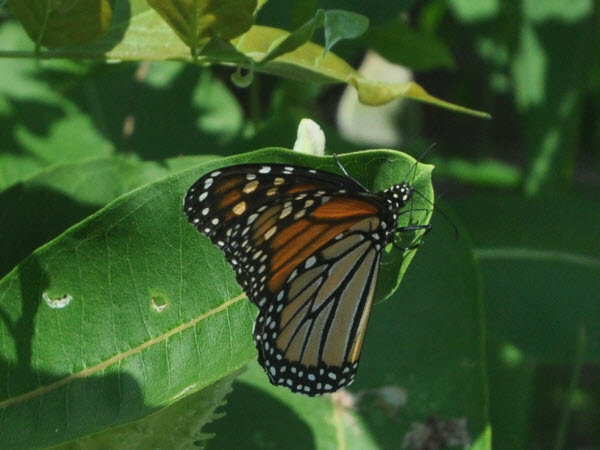
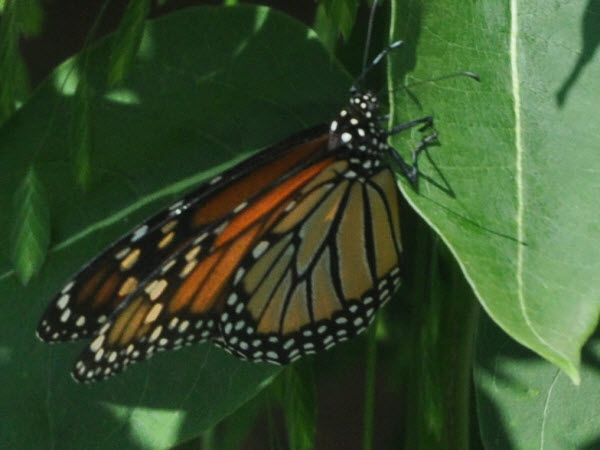
Milkweed Bug - Oncopeltus fasciatus
ref: http://www.cirrusimage.com/bugs_large_milkweed.htm
ref: http://www.mymonarchguide.com/2008/05/milkweed-bugs.html
Best to read the references, but can't help pasting in a summary in bullet points about this milkweed bug:
- There are two types of Milkweed Bugs – Large and Small Milkweed Bugs (LMB and SMB). Both feed on the seeds of the milkweed plant
- Life-cycle – like the ladybug, they do not go through complete metamorphosis when developing from egg to adult. The babies, or nymphs, look kind of like the adults but don’t have any wings nor any reproductive organs. They also lack the black spots initially.
- Females oviposit (lay eggs) in small areas / crevices between the pods on the Milkweed plant. She will oviposit about 30 eggs a day, and can lay up to 2,000 in her lifetime (one month).
- In about 4 days the bright-colored nymph hatches. LMB and SMB grow by a series of molts, and the stages are called instars. Each instar lasts approximately a week.
- As they grow, LMB and SMB are gregarious and can often be seen gathered together in one spot on a Milkweed plant – and if the plant is touched or disturbed, then all of these brilliantly-coloured critters scatter!
- The Milkweed latex (sap) contains cardiac glycosides, a type of cardenolide. Because the Milkweed Bugs feed on the milkweed, they also contain the cardiac glycosides. A predator that eats a Milkweed bug will likely vomit, and in quantity, the cardiac glycosides will arrest the heart.

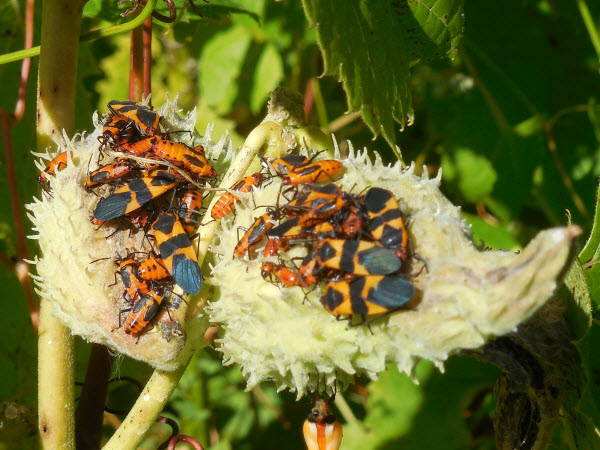
Tussock Moth Caterpillar
There are several milkweed plants growing in our backyard - a growing colony, as they spread via rhizomes growing out from the roots of existing plants. A single milkweed leaf on a single plant was completely covered by caterpillars one morning, and they were systematically moving from leaf to leaf, completely consuming each before moving on. Except for the veins within each leaf. I learned that the veins contain a milky latex that can entrap and kill the caterpillars, and so they leave these carefully intact.

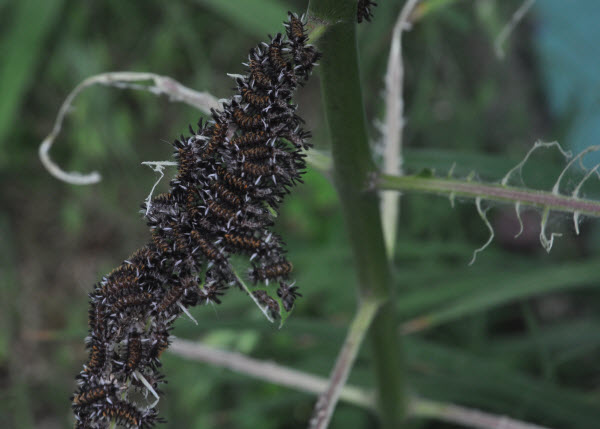

The front edge - I just love this view - the body of the caterpillars hidden from view, only the shiny eyes present along the edge as they eat their way in.
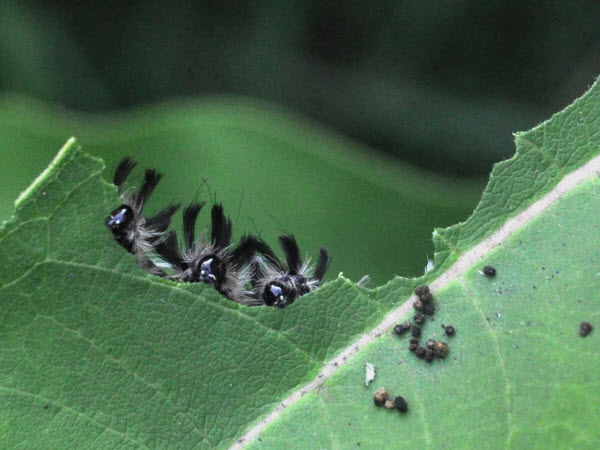
By the end of the week these Tussock caterpillars had grown substantially, and their numbers were tremendously reduced. All those cardiac glycosides they presumably ingested presumably left some bird or other predator with a stomach ache! I was not aware that the caterpillars ate the pods - and this was the only instance that I saw on this particular milkweed plant.

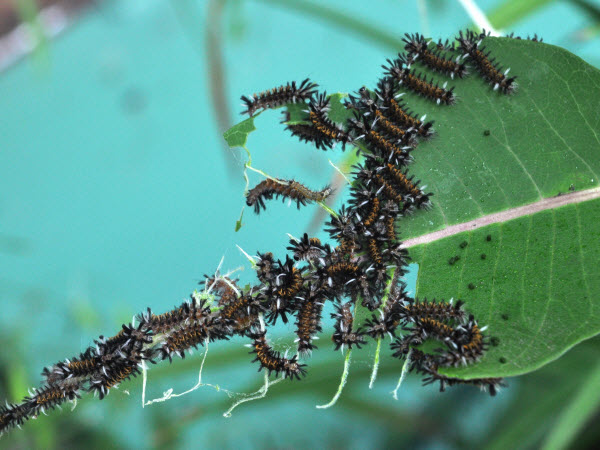
Such care eating all of the leaf and leaving all of the veins! It seems as if even a fine mesh of veins between the major veins is left behind.
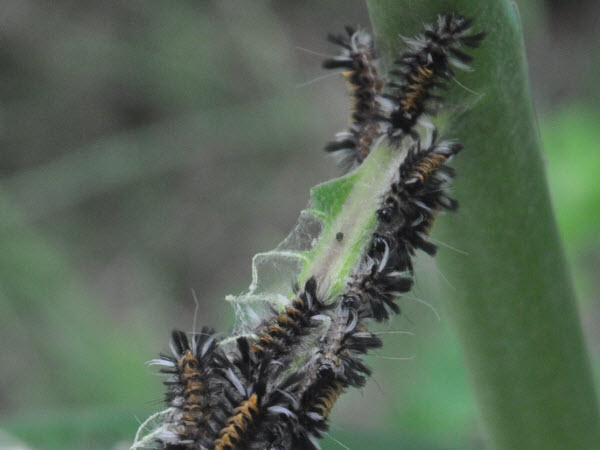
In a matter of days they totally consumed all of the leaves of this particular plant, though the others nearby were undamaged.
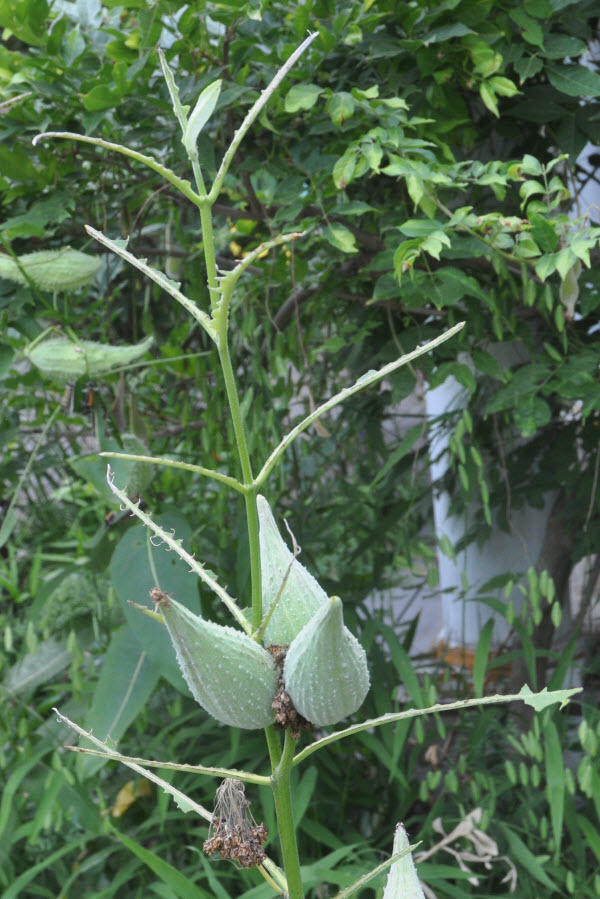

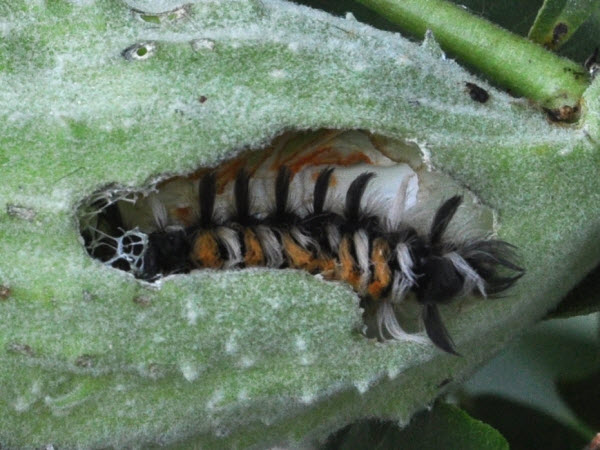
Flies
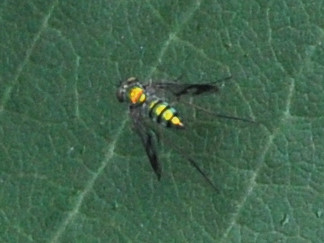
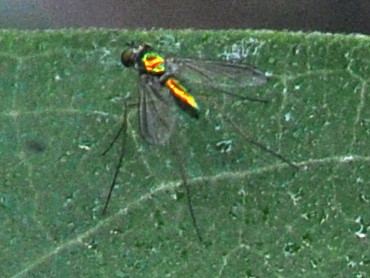
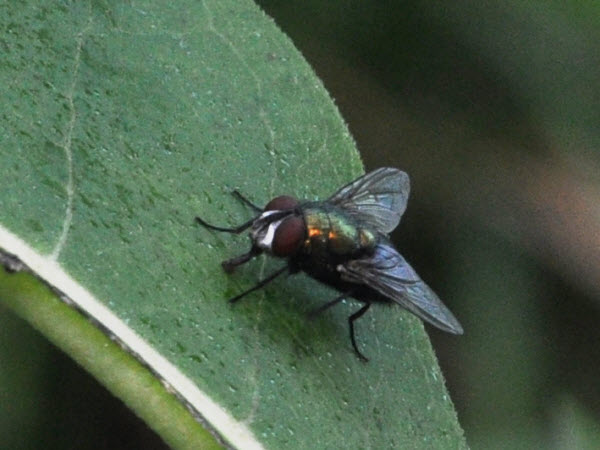

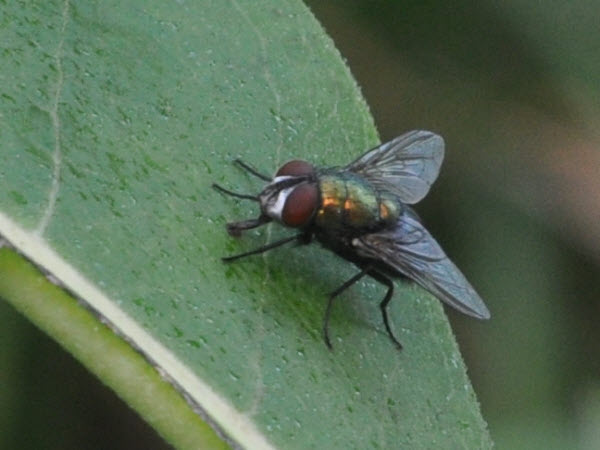
Witch Hazel bush - early spring blossoms often begin well before all of the snow has melted.
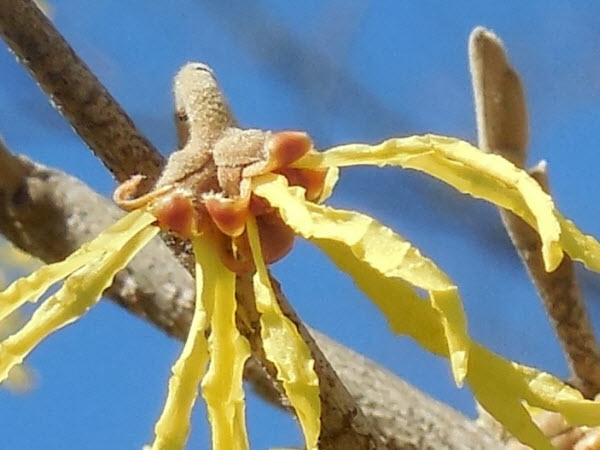

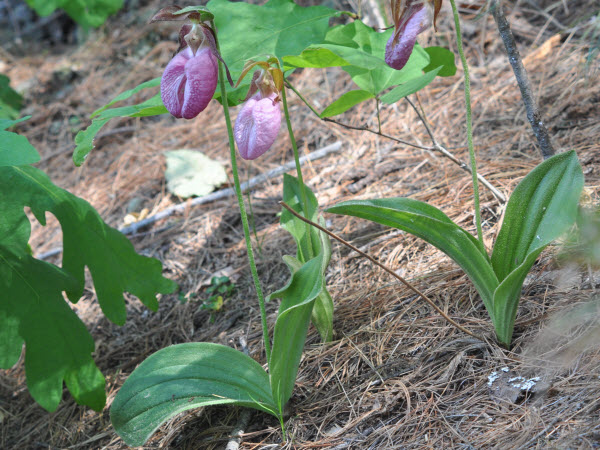
This moccasin flower, also called a pink lady's slipper, is a member of the orchid family. See the single pair of basal leaves and the leafless stem.
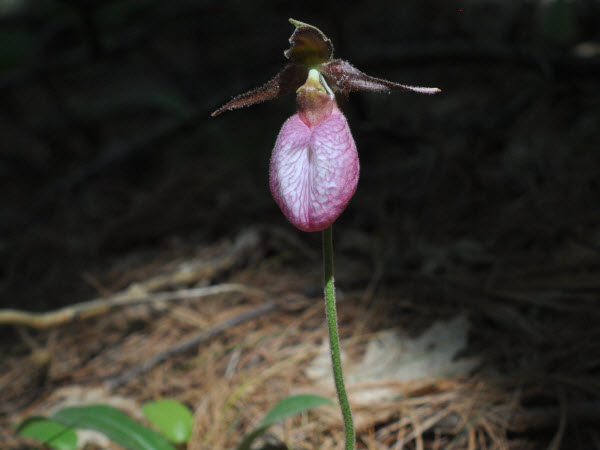
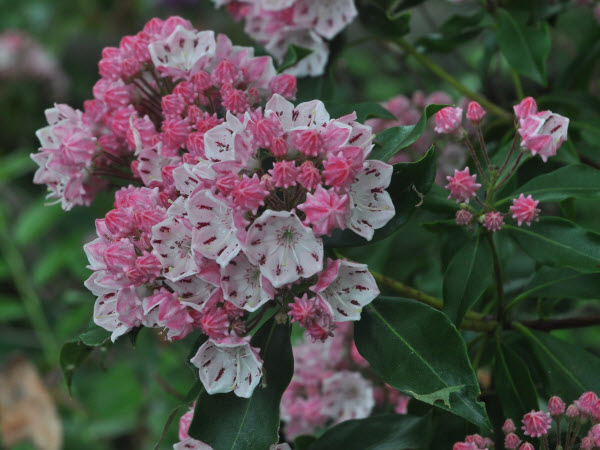
Peony, early June
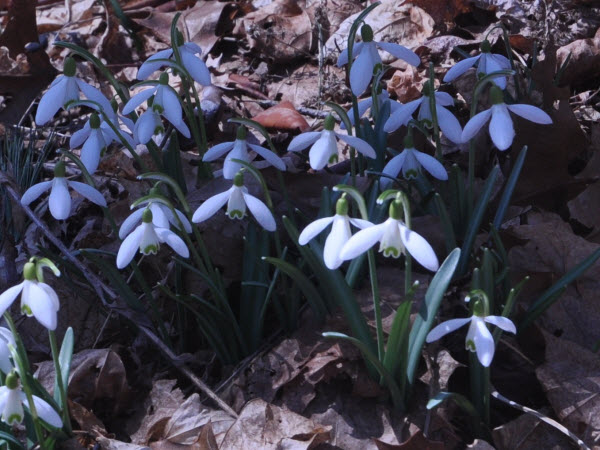
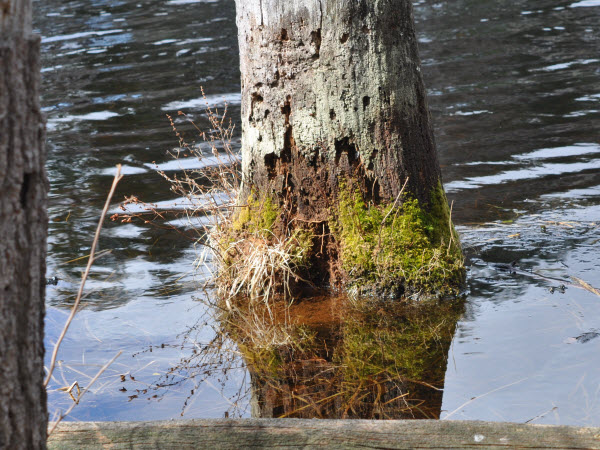
Slender marsh-pink
Mountain Laurel. These pictures are reduced to 600 x 450 pixels - they still tend to look sharp, but for me an image like this, at full resolution, is fun to look at - so much detail in the structure of the flower.
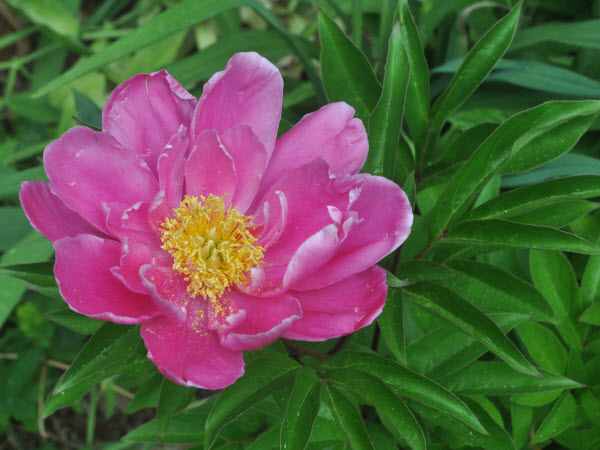
Snowdrops - some of the first flowers to push up through the snow in early spring - although this image is from June 17!

